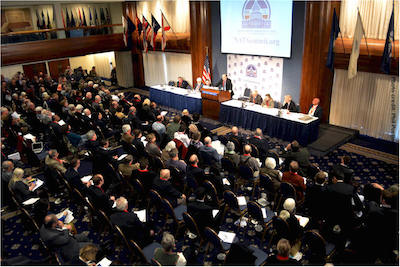Gaza war inspires new forms of resistance, and art
Sep 20 2014 / 12:59 amBy Pam Bailey.
Pam in Progress – The Palestinian poet Mahmoud Darwish once wrote that “against barbarity, poetry can resist only by confirming its attachment to human fragility, like a blade of grass growing on a wall while armies march by.”
During what will likely become known as the “Second Great War Against Gaza,” whitewashed by Israel with its “Operation Protective Edge” name, there was literally a field of resilient blades of grass – artists fighting back against injustice with their creativity. Only this time, more than at any other, their art supplies were digital and their “galleries” were social media.
“The Israeli blockade on Gaza makes art materials very expensive, and artists here can’t afford them,” explains Basel Elmaqosui, 42 and a resident of Gaza City. “With the war, it truly became impossible to use brushes and paint. But I felt strongly that I had to express what this brutal offense was doing to my people. The Western news media were just talking about numbers and facts; they weren’t looking the souls of people here, and the pain.”
So Elmaqosui got creative. He combined photographs he took of the destruction that now characterizes Gaza with images of classical paintings he found online – visuals that Americans and Europeans are used to seeing. The contradiction between the two screams for attention, as if to say, “how can such inhumanity be allowed to exist when the world seeks beauty?”
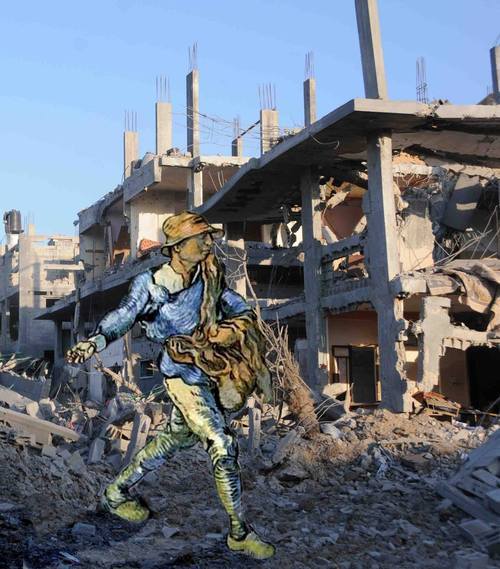
Along with two other artists in Gaza, Elmaqosui formed a gallery called Windows From Gaza, an entity that is rare in the Strip, since it is difficult to make a living with art when most residents struggle just to support themselves. A portion of their meager proceeds goes toward workshops to nurture the expressiveness of children and the skills of aspiring artists. However, the hardships imposed by the recent Israeli assault have made social media his primary way of sharing his work with the world.
Turning destruction into art
Another Gaza artist who found creative expression through imaginative digital manipulation is Tawfiq Abdel Rahman Jibril, a 27-year-old lecturer in architecture at the University of Palestine. He has loved drawing since childhood, but pursued architecture as a profession because it was more practical as a way to attempt to make a living. However, his dream is to go overseas to exhibit, where there is more of an ability to care about good art and to nurture young talent.
Meanwhile, art continues to be a hobby for Jibril, and during the war, he became fascinated with the idea of converting the smoke from bombs into images that range from hope, to resistance, to dreams of another world. Soon, with the help of Adobe Photoshop, his “re-imagining” of the after-effects of Israeli bombs were circulating on Facebook.
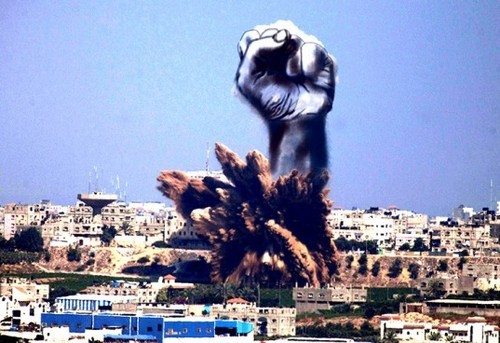
“Some people resist with weapons and violence,” says Jibril. “This is my form of resistance.”
The idea of transforming the ubiquitous smoke plumes into art has caught the fancy of several artists and it is difficult to say who was first. Another artist who has excelled in this particular “medium” and who has formed a sort of partnership with Jibril is 25-year-old Bushra Shanan – from Hebron in the West Bank.
“Since I am Palestinian, it is my duty to resist the occupation through my talents, and that is my art,” she says, adding that what hurts her kinspeople in Gaza hurts her. “When the world looks at pictures of Gaza under attack, it sees only smoke and ashes and destruction. But Palestinians see the stories behind the smoke: the martyrs, and the children and women who must learn to live without the basic necessities of life.”
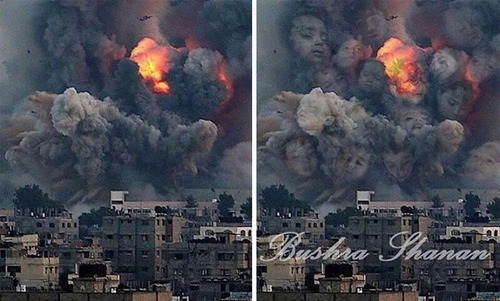
Art as a ‘unifier’
The Israeli assault on Gaza has indeed united Palestinians everywhere, perversely bringing them together even as Israel seeks to divide and conquer. In Jordan, the Israeli blockade and assault has reinforced the connection of 45-year-old Imad Abu Shtayyah to her homeland. Her parents were forced to emigrate from Palestine in 1948, and she was born in a refugee camp in Amman.
Abu Shtayyah graduated from university there with a degree in computer programming and aeronautical engineering. However, she has been interested in art since she was just eight years old, when painting helped her recover from a traumatic experience – just as it is being used today to help the children of Gaza overcome the effects of war. As she developed as an artist, a common theme in her work became the role of women in preserving Palestinian culture.
“The woman is at the center of our culture. They create and nurture the next generation,” explains Abu Shtayyah. The image she created of a woman rising up from a Gaza village, with a skirt made of destroyed homes, became one of the most shared artworks on Facebook, with many using it as their profile photo.
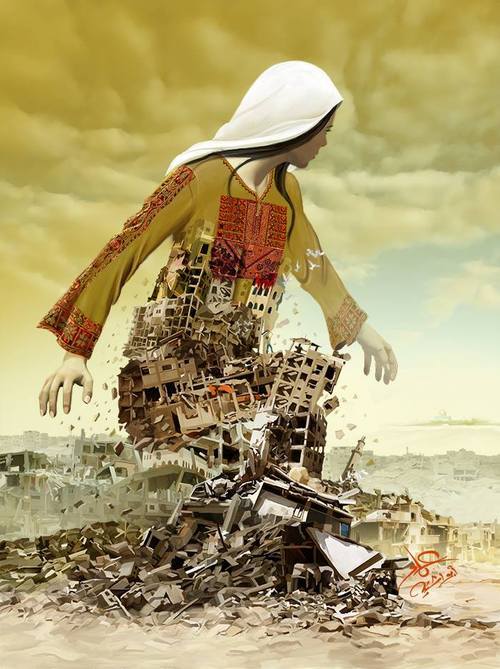
She wrote this poem to accompany the multi-media image:
From the destruction and hatred you sow
From every inch of our land
That hosted a martyr
We shall return…
Despite of your killing and brutality
and the collaboration of traitors
who sold out
helping to realize your schemes
in our Palestine.
We shall return to our land
to the land of our ancestors!
But even more popular on Facebook was the image known as the “four boys.” The simple photograph shows an orange-hued sunset, with the reflections of four young boys in the water lapping on the beach below. What everyone who sees the image knows is that it was inspired by the shocking killing of the four Bakr cousins, all between the ages of 9 and 10, while they were playing football on a Gaza City beach July 16. The Israeli military acknowledged later that it had launched the strike that hit the boys, and has yet to produce any evidence that there was any fighting or arms caches in the area.
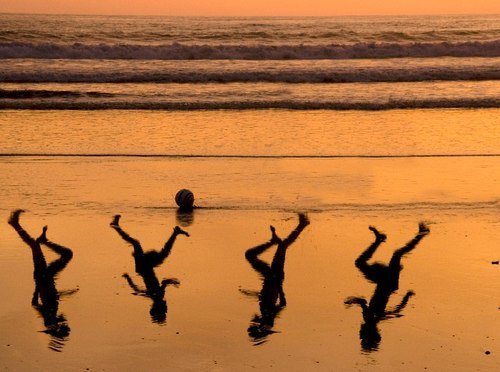
What many of the Palestinians and activists who share the image on Facebook don’tknow, however, is that the creator is an Israeli Jew – and a third-generation descendant of Holocaust survivors.
“The Holocaust is the ultimate Israeli excuse for why they have to be so suspicious of the ‘other.’ But it’s no way to live a life. My parents didn’t live this life and I refuse to as well,” says Amir Schiby, a musician from West Jerusalem who describes his art as a hobby.
Just a few hours after word spread of the tragic Bakr deaths, Schiby saw a photograph of four children playing on a beach. He manipulated it by using Photoshop to “erase” the bodies, leaving only their reflection. A short while later he shared it on Facebook, it spread to Twitter and the rest is history.
“I am considered by others to be a left-wing humanist,” says Schiby. “But to me, it’s simple. Palestinians are, and always will be, my neighbors. It burns my soul to see innocent people dying.”
Want to help me and the new nonprofit I co-founded (New Generations for Palestinian Children and Youth) bring these talented artists to North America for an exhibition? Respond here and let me know! We plan to auction off their work to raise money for art workshops in Gaza.

